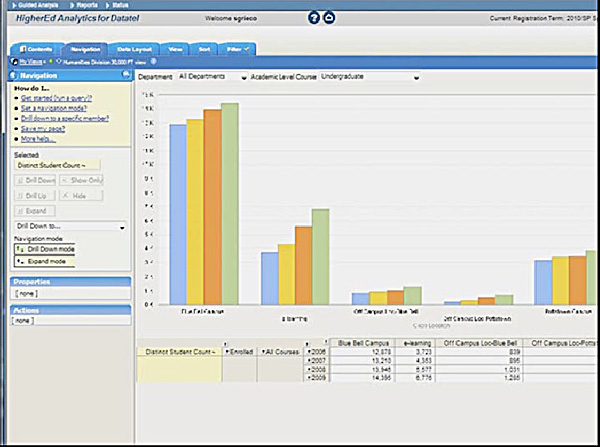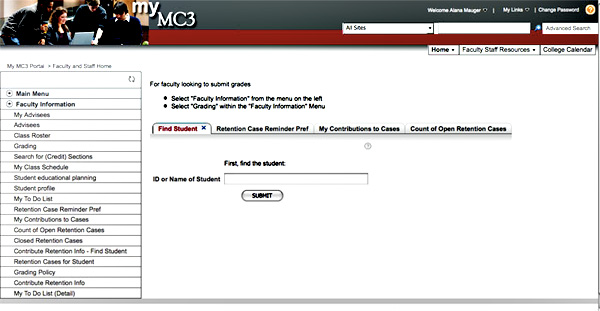Key Takeaways
- Data-informed decision making helps higher education institutions know whether they are achieving their missions, including expanding access to higher education and increasing student success.
- At Montgomery County Community College, technology supports both Information Technology and Institutional Research by providing data and analytics directly to end users.
- While year-to-year increases in student retention are modest, the persistence rate for African American students has increased by 8.2 percent from 2004, with a 2009 fall-to-spring persistence rate of 71 percent.
For three consecutive years, Montgomery County Community College (MCCC) has been ranked among the top community colleges in the country for its use of technology to support and enhance teaching and learning. MCCC received an A+, the highest grade possible, in the 2010 national Digital Community Colleges Survey administered by the Center for Digital Education and Converge Online. The sixth annual survey examined community colleges' use of technology to enhance the student experience and increase educator effectiveness.
At a recent "technology block party" on campus, students filmed a news video of interviews with staff and faculty about technology at MCCC.
MCCC President Karen A. Stout attributes MCCC's success in this area to its "data culture" and the use of technology to help administrators and faculty make data-informed decisions that support student learning outcomes. She explained:
"The college's data-informed decision making is essential for continuous improvement because, unless you have a system-wide structure that collects data, analyzes it, and makes adjustments on a routine basis, you really don't know if you're achieving your mission. By adapting national best practices, we are constantly assessing ourselves, always trying to make our student outcomes better using technology as a tool to focus on teaching and learning."
As defined in its mission and strategic plan, MCCC is committed to expanding access to higher education and increasing the success of its students. The institution's work with such national initiatives as Foundations of Excellence in the First College Year, Title III, and Achieving the Dream supported its Student Success Initiative, one element of which is to develop a strong first-year experience, thus improving student retention as well as graduation and transfer rates.
Accessible Data and Reporting
With an increase in student enrollment of more than 35 percent over the past 10 years, the need for immediate information and analytics also continued to grow. Soon, the demand for customized data outpaced the ability of Information Technology (IT) and Institutional Research (IR) to produce requested reports in a timely manner for dozens of areas and individuals throughout the college.
The IT team worked closely with college decision makers to identify unmet data needs in the areas of enrollment management, student performance, institutional research, and ongoing academic program reviews. In early 2007, the team deployed a new executive dashboard tool, the iStrategy HigherEd Analytics Student Module, that enables end users to access data at the level they need, when they need it. According to Kathy Miller, project lead for administrative systems, with the new analytics tool "deans and directors are now able to access the exact data they need, without first requesting a report from IT or IR and waiting for the information." Furthermore, because the tool fully integrates with MCCC's current Datatel ERP system, end users worked with live data as opposed to test data during training.
Today, administrators and deans use the analytic tool on a daily basis to monitor both college-wide and program-specific enrollment trends. According to Kathrine Swanson, vice president of institutional effectiveness and enrollment management, "old reports and database queries would yield cause to wonder questions that could not readily be answered. Our executive dashboard now delivers KPIs and drill-down capabilities for a clear understanding of what is happening."
Kathrine Swanson explains the value of evidence to the student success initiative:
Key Points from Swanson's Podcast
As an example of using this analytical tool, consider Dean of Arts and Humanities and Interim West Campus Administrative Officer Stephen Grieco. Weekly, Grieco reviews in-depth enrollment analysis by campus, area of study, and individual courses within his division. He reviews the enrollment data with individual program coordinators to identify what enrollment strategies are working and which need to be changed to ensure that programs remain relevant and meet the learning needs of the students. Figure 1 shows a report from iStrategy.
Stephen Grieco talks about a culture of data analysis and use:
Key Points from Grieco's Podcast

Figure 1. Screenshot of iStrategy Report
Student Intervention Strategies
While monitoring enrollment trends and making necessary program changes has a long-term impact on student retention, the college's Student Success Center staff recognized that at-risk students would benefit from immediate interventions at points throughout the semester. The staff also recognized that a student's academic grade is not the only indication that a student might be at risk for not completing a course or program of study.
In mid-2010, MCCC tested a new retention alert tool, Colleague Student Retention Alert, which has since significantly changed the way counselors, advisors, and faculty track and communicate with at-risk students with the goal of keeping them enrolled (see Figure 2). The tool was initially rolled out as a pilot that included faculty who teach Strategies for College Success. The two-credit introduction-to-college course is mandatory for students who place into two or more developmental (pre-college level) courses — students who the data show are at the greatest risk for not completing their coursework.

Figure 2. Opening Screen of Student Retention Alert Tool
Made available to all faculty in fall 2010, the tool allows instructors to report students who are exhibiting at-risk behaviors, such as excessive absences, poor academic performance, and severe conduct issues. When an alert is initiated, a case is automatically generated and sent to a counselor in the Student Success Center. The counselor can then continue to track and communicate with the student throughout the semester or through the student's entire time at the college. Counselors also use the tool to communicate with specific cohorts of students, such as those in developmental courses.
According to Nina Xu, project lead for administrative business systems, benefits of the new retention tool include the consistent and complete documentation of student cases, the reinforcement of case progression, and the ability to effectively monitor retention. From an IT perspective, the tool readily integrates into other systems currently in use, such as Datatel and SARS (Scheduling and Reporting Services), discussed next.
The Student-Advisor Experience
Over the past several years, students have consistently responded unfavorably to questions about their experiences with academic advising on the Community College Survey of Student Engagement (CCSSE), which IR administers annually. A lack of general organization and long wait times, both in person and on the phone, to speak with an advisor were identified as areas needing improvement.
According to Steady Moono, vice president of student affairs, during peak registration times Student Success Center staff had up to 40 voicemail messages from students at the end of each day. He explains that, at other times, "a student might be transferred four to six times throughout the institution, because each department could only answer questions relevant to its specific function. Obviously this was not an effective strategy for attracting new students or helping students succeed."
To address the issue of more organized scheduling, MCCC rolled out a new scheduling system, SARS GRID, to improve the efficiency with which students make Student Success Center appointments (see Figure 3). This web-based scheduling grid enables the center's front desk staff to assign walk-in students to an available advisor or provide them with the length of time they must wait in the queue. Because they can view the schedules of multiple advisors and counselors on multiple dates on one screen, staff members can quickly and efficiently help students select appointments that best fit their schedules and areas of study, thus improving a student's initial contact (see Figure 4).

Figure 3. Student Success Center

Figure 4. Student and Advisor in the Student Success Center
In the past year, MCCC rolled out eSARS, an online component to the tool that enables students to register for appointments using the college's online student portal. Students can also register for appointments with tutors and peer mentors using the tool. According to Business Systems Trainer Gerri Light, MCCC looks to expand online scheduling services in the future to include course testing appointments.
To address the frequent occurrences of phone transfers, voicemails, and time spent on hold, MCCC established a call center with three trained operators who can answer most student inquiries. If a representative cannot fully assist a student, he or she transfers the caller to an available advisor using the integrated scheduling tool. Moono reports that "the number of calls to my office from frustrated students unable to find information has fallen by more than 95 percent." Further, 80 percent of all incoming calls are now answered within 30 seconds.
While improving the level of service that call-in students receive, the call center implementation also improved student satisfaction with face-to-face interaction at MCCC's campuses. Call Center Manager Barbara LeFevre reports that "the pressure on other staff members to answer general incoming phone calls has also fallen," enabling frontline staff to more effectively assist students in person and reduce the number of students in the queue.
Next Steps
According to the data available from 2008 and 2009, MCCC has seen a small increase in the fall-to-fall and fall-to-spring persistence rates, especially among African American students.
- The 2009 fall-to-spring student persistence rate is 68.9 percent, an increase of 1.5 percent from fall 2008 and a five-year increase of 2.9 percent (up from 66 percent in 2004).
- The persistence rate for African American students has increased by 8.2 percent from 2004, with a 2009 fall-to-spring persistence rate of 71 percent.
- The 2009 fall-to-fall student persistence rate is 47.6, which is the same as fall 2008 and is a five-year increase of .7 percent (up from 46.9 percent in 2004).
Although the improvement from fall to fall is not as dramatic as the fall-to-spring increase, the college has narrowed the achievement gap in persistence rate for African American students, with a 2009 fall-to-fall persistence rate of 46 percent, which is up 3.3 percent from 42.7 percent in 2004.
While the increases in persistence are modest, the tools and strategies implemented have begun to change the way MCCC evaluates its courses and programs for effectiveness, assists students in navigating the college process, and provides early intervention for students when a problem arises. Combined with other strategies in the Student Success Initiative — such as learning communities, supplemental instruction, and a minority male mentoring program — as well as state-of-the-art learning spaces and interactive classroom technology, MCCC strives to further improve student retention and success.
© 2010 Celeste Schwartz, Mary Lou Barron, and Alana J. Mauger. The text of this article is licensed under the Creative Commons Attribution-Noncommercial-No Derivative Works 3.0 license.




